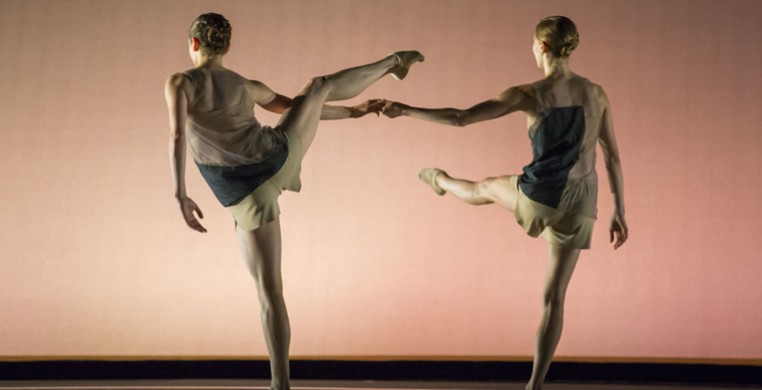It’s not often audiences get to experience a single concert with the scope of choreography and superb performing that The Chicago Dancing Festival brings to the city each summer. And it’s free!
Wednesday night’s opening, the first of three concerts that took place through Saturday, gave us an evolution of dance in America.
Two classics of the American dance canon--Jerome Robbins’ Fancy Free(1944), performed by stars of the New York City Ballet, and Martha Graham’s Errand Into The Maze (1947)--still shine today as beacons of choreographic innovation, reminding us of the unique capabilities of dance to move an audience through story. Both pieces were performed with a freshness that has withstood the test of time, continuing to engage and entertain. What makes them endure?
As America fought a devastating war in Europe, Robbins blasted through the barriers that separated classical ballet, contemporary dance, and musical theater with a light-hearted story about sailors on leave in New York. From the first sissone to the last pitch of gum wrappers into the wings, each gesture gave voice to distinctive characters, each rond de jambe another sentence in the dance dialogues that revealed all the elements of a good story, and good theater--time, place, plot, character, relationship, conflict, and resolution. Today’s choreographers can take a few cues from Fancy Free. For one, you can make great dance theater from an everyday story about everyday people, at least Robbins sure could. The brilliance of Fancy Free--clearly foreshadowing Robbins’ stunning achievement in West Side Story--lies in his total reliance on movement invention for storytelling. Dramatic action is completely integrated into choreographic sequence, music, and spatial design, creating a theatrical unity that delivers meaning through dance. Robbins’ ability to manipulate classical ballet vocabulary to accommodate and embody the impulses and gestural language of street vernacular and everyday speech are nothing short of inspired.
Equally innovative but at the opposite end of the storytelling spectrum were dancers PeiJu Chien-Pott and Abdiel Jacobsen of The Martha Graham Dance Company in an epic re-imagining of the ancient Greek myth of Theseus and the Minotaur. Errand Into The Maze sends a woman into the labyrinth instead of Theseus for a life and death confrontation with the dreaded Minotaur, half-man, half-bull. Graham uses the story to frame a journey into the darkness of the human psyche, fraught with sexuality, fear, domination, and, ultimately, self-empowerment. Like Robbins, Graham was able to penetrate the truth of the human condition entirely through a codified dance vocabulary, one she created herself to explore the darker, messier aspects of human psychology that conventional ballet and theatrical dancing had yet to touch. Her use of the contraction and release and the spiral to generate impulse from the core of the body, radiating out through the sting of extended limbs, cupped hands, and flexed feet, was a discovery that has had resounding impact on western theatrical dance. We were treated to the original Isamu Noguchi set, which so aptly reflects, through abstract line and shape, Graham’s interior landscape and the metaphor of the labyrinth. In Ms. Chien-Pott’s spectacular articulation of the Graham technique, every ripple of abdominal contraction resonated in emotional intensity. Her anticipation and dread built suspense through the stirring momentum of a circling leg, the angular dive of a spiral turn pitched dangerously toward the floor, the defiant resolve of an extension that reached the rafters. Mr. Jacobsen’s horrifying Minotaur threatened sexual domination and destruction in bounding straight-leg, flexed foot sautés and battements that hammered the air like lethal weapons.
Contrasting the two historic works, Yuri Possokhov’s stunning excerpt from Bells (2011), danced by two of Joffrey’s finest, and Kyle Abraham’s Festival-commissioned “Counterpoint” for Hubbard Street Dance Chicago (a CDF first), told stories of a different kind in abstract, non-linear structures that were equally rich for their use of movement to transmit the deeper truth of human experience in a way that is unique to dance.
In a lyrical love duet that paired real-life husband and wife Victoria Jaiani and Temur Suluashvili, Possokhov takes the miraculous beauty of human bodies on a journey of togetherness, tender, intimate in its partnering, exquisite in its emotional poignance. Set to the music of Rachmaninov and performed live by pianist Mungunchimeg Buriad, this impressionistic interlude was a great example of the contemporary blurring of boundaries between classical ballet and modern dance, with an emotional language that combined supported lifts and pirouettes en pointe with flexed feet and contractions.
“Counterpoint” (premiere) thrust seven Hubbard Street dancers into an uncertain world of abrupt change, static white noise, and ever-parting curtains. Staccato jabs and angular isolations cast haunting shadows across the upstage curtains. A sense of held breath and arial suspension drove the discomfort of dancers at the mercy of forces beyond their control with erratic shoulder isolations, hits and twitches, and extreme body stretches. Abraham’s choreography held intensity with unusual choices in the relationship of movement to music. Beginning with the discomfort of static noise of the opening, movement clashed against the dissonant drone of an electronic score. Shifting gears in a breathtaking partnership with Brahms became a trompe l’oeil of deceptive lyricism--you really began to hear the music in a new and different way. Mystifying with an endless round of crowd cheering and applause, the concluding segment ended with the dancers breaking form and walking offstage. Unsettling and magnificent, this new work made a thrilling case for the uncertainty of life while still holding out hope for its redemption.
The program concluded with Elliott Feld’s The Jig Is Up, (1984) for the Juilliard School, a wispy Gaelic romp with folk dance roots that gave the student dancers material they could bite into with youthful joy and exuberance.
Of special note--Wednesday night’s performance was simulcast live from the packed, 1500-seat Harris Theater to the outdoor Pritzker Pavillion and lawn, which accommodates thousands more, a first for the Chicago Dancing Festival, and hopefully the beginning of a new tradition that brings an even greater public audience to this special festival.

